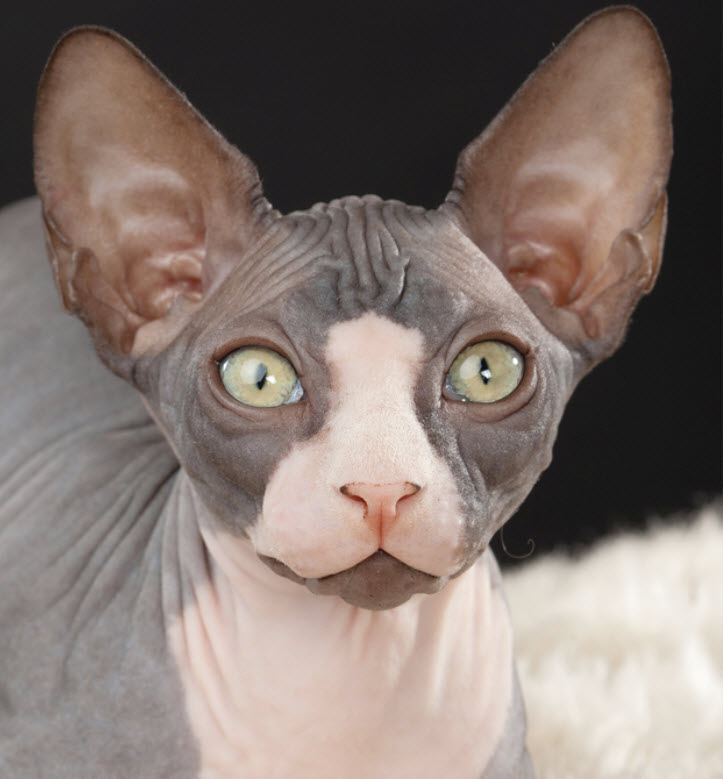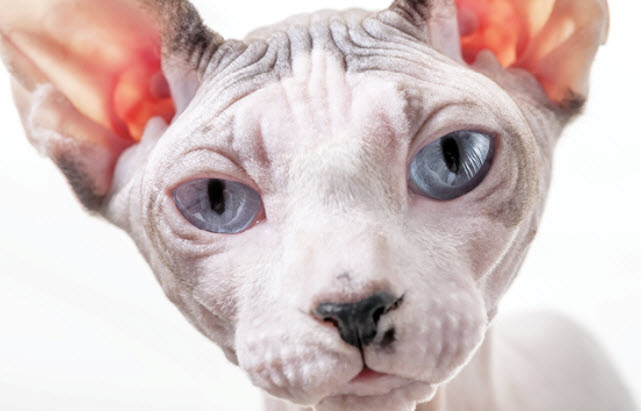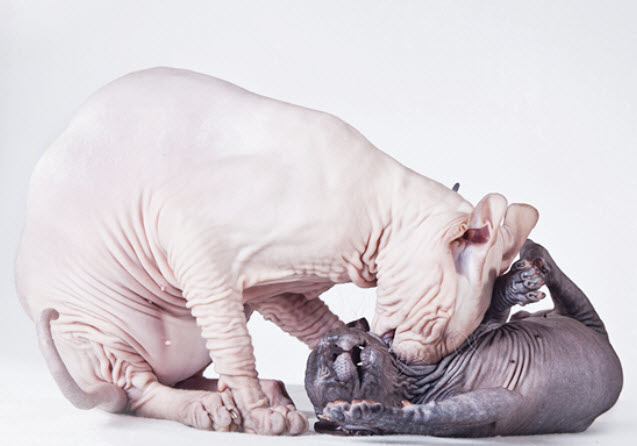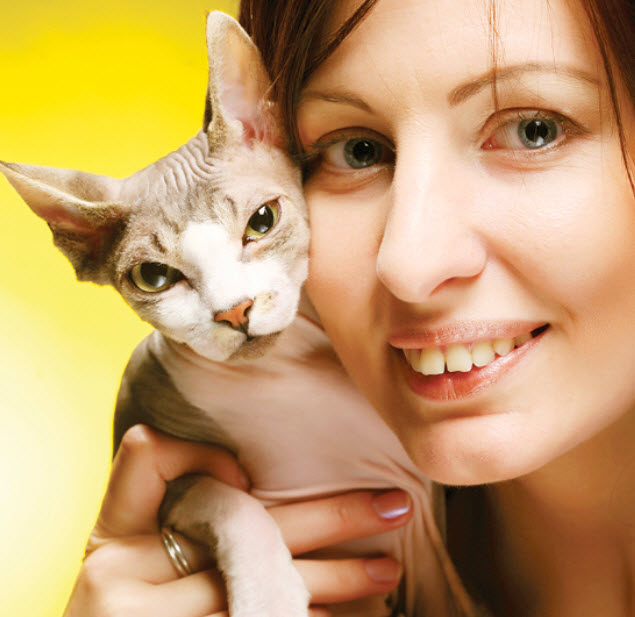
Your Cat and Her Quirks
Not everyone finds the Sphynx (or "Hairless Cat") so endearing. But we know you'll love her because she is:
- Devoted and loyal
- Playful, especially with "chase" games
- Quirky, with an entertaining personality
- A jumper who loves being in high places
- Social - enjoys the company of other cats and people
- Highly intelligent and able to learn tricks
But you may have also noticed these characteristics:
- May want to constantly be involved in your activities
- People-oriented and should not be left alone for long periods of time
- Can become chilled in cold weather
- Very talkative, has an opinion about everything
- May be mischievous if not given enough attention
- May resist being picked up and carried
 The bottom line is that this kitty is a silly and energetic companion that can be demanding of attention. She is well suited to active homes with multiple pets or children.
The bottom line is that this kitty is a silly and energetic companion that can be demanding of attention. She is well suited to active homes with multiple pets or children.
The Sphynx is recognized as a Canadian breed first occurring as a natural mutation in a litter of Domestic Shorthaired cats. The breed was further developed by crossing with the Devon Rex. The Sphynx lacks a fur coat but does have a sparse covering of downy fur mainly found on their ears, face, tail, and feet. The Sphynx should be kept indoors only as they are highly sensitive to the cold and are easily sunburnt. The Sphynx is a highly active and affectionate companion often described as part cat, part dog, and part monkey. They are known for their heat-seeking behavior; commonly found on top of computers or televisions, in sunny windows or under blankets. The Sphynx has an extroverted personality, enjoys entertaining and will often be the first to greet anyone who enters their home.
Your Sphynx's Health
We know that because you care so much about your cat, you want to take great care of her. That is why we have summarized the health concerns we will be discussing with you over the life of your Sphynx. By knowing about the health concerns common among Sphynxes, we can help you tailor an individual preventive health plan and hopefully prevent some predictable risks to your pet.
Many diseases and health conditions are genetic, meaning they are related to your pet’s breed. The conditions we will describe here have a significant rate of incidence or a strong impact upon this breed particularly, according to a general consensus among feline genetic researchers and veterinary practitioners. This does not mean your cat will have these problems, only that she may be more at risk than other cats. We will describe the most common issues seen in Sphynxes to give you an idea of what may come up in her future. Of course, we can’t cover every possibility here, so always check with us if you notice any unusual signs or symptoms.
This guide contains general health information important to all felines as well as information on genetic predispositions for Sphynxes. The information here can help you and your pet’s healthcare team plan for your pet’s unique medical needs together. At the end of the article, we have also included a description of what you can do at home to keep your Hairless Cat looking and feeling her best. We hope this information will help you know what to watch for, and we will all feel better knowing that we’re taking the best possible care of your friend.
General Health Information for your Sphynx
Weight Management
Obesity is a major disease that contributes to a surprisingly large number of illnesses and deaths in cats.
This revelation is more well-known and well-understood today than in the last few decades, but too many owners are still ignoring the dangers of extra weight on their pets. Excess weight is one of the most influential factors in the development of arthritis, diabetes, and other life-threatening diseases. Everyone knows—many firsthand from personal experience—how even shedding just a few pounds can result in improved mobility and increased overall motivation to be active. And the same is true for your pet.
Research suggests that carrying excess weight may shorten a pet’s life by as much as two years, and can cause the onset of arthritis two years sooner. Diabetes, an inherited disease, has a much higher chance of developing in overweight pets, and may never become a problem for a healthy-weight cat. The more obese a cat becomes, the more likely it will become diabetic. Hepatic lipidosis, or fatty liver, is another potentially fatal disease in overweight pets; hepatic lipidosis can develop in as few as 48 hours when an overweight cat stops eating for any reason.
So how can we help our pets stay trim? Understanding your cat's dietary habits is key. The average cat prefers to eat about 10-15 times a day, just a few nibbles at a time. This method, free-feeding, works well for most cats, but boredom may increase the number of trips your cat makes to the food bowl. By keeping your cat playfully active and engaged, you'll help your pet stay healthy and have some fun at the same time! A string tied to a stick with something crinkly or fuzzy on the other end of the string, and a little imagination—you and your cat will both be entertained. Food puzzles, like kibbles put in a paper bag or under an overturned basket or box, may help to motivate cats with more food-based interests to romp and tumble.
For really tough cases of overeating, you will have to take a firm stance, and regulate your cat’s food intake. Instead of filling your cat’s bowl to the top, follow the feeding guide on the food package and be sure to feed a high-quality adult cat diet as recommended by your vet. Replace your cat's habits of eating when bored with extra playtime and affection. Cats typically adjust their desires for personal interaction by the amount of affection offered to them, so in other words, ignoring your cat means your cat will ignore you. By the same token, loving on and playing with your cat a lot will cause your cat to desire that time with you. A more active cat means a healthier, happier pet—and owner!
 Dental Disease
Dental Disease
Dental disease is one of the most common chronic problems in pets who don’t have their teeth brushed regularly. Unfortunately, most cats don’t take very good care of their own teeth, and this probably includes your Sphynx. Without extra help and care from you, your cat is likely to develop potentially serious dental problems. Dental disease starts with food residue, which hardens into tartar that builds up on the visible parts of the teeth, and eventually leads to infection of the gums and tooth roots. Protecting your cat against dental disease from the start by removing food residue regularly may help prevent or delay the need for advanced treatment of dental disease. This treatment can be stressful for your cat and expensive for you, so preventive care is beneficial all around. In severe cases of chronic dental infection, your pet may even lose teeth or sustain damage to internal organs. And, if nothing else, your cat will be a more pleasant companion not knocking everyone over with stinky cat breath! We’ll show you how to keep your cat's pearly whites clean at home, and help you schedule regular routine dental exams.
Vaccine-Preventable Infections
Like all cats, Sphynxes are susceptible to bacterial and viral infections such as panleukopenia, calicivirus, rhinotracheitis, and rabies, which are preventable through vaccination. The risk of your cat contracting these diseases is high, so the corresponding vaccines are called “core” vaccines, which are highly recommended for all cats. In addition, vaccines are available to offer protection from other dangerous diseases like feline leukemia virus (FeLV). In making vaccination recommendations for your cat, we will consider the prevalence of these diseases in our area, your cat’s age, and any other risk factors specific to her lifestyle.
 Parasites
Parasites
All kinds of worms and bugs can invade your Hairless Cat's body, inside and out. Everything from fleas and ticks to ear mites can infest her skin and ears. Hookworms, roundworms, heartworms, and whipworms can get into her system in a number of ways: drinking unclean water, walking on contaminated soil, or being bitten by an infected mosquito. Some of these parasites can be transmitted to you or a family member and are a serious concern for everyone. For your feline friend, these parasites can cause pain, discomfort, and even death, so it’s important that we test for them on a regular basis. Many types of parasites can be detected with a fecal exam, so it’s a good idea to bring a fresh stool sample (in a stink-proof container, please) with your pet for her twice-a-year wellness exams. We’ll also recommend preventive medication as necessary to keep her healthy.
Spay or Neuter
One of the best things you can do for your Sphynx is to have her spayed (neutered for males). In females, this procedure includes surgically removing the ovaries and usually the uterus; in males, the testicles are surgically removed. Spaying or neutering your pet decreases the likelihood of certain types of cancers and eliminates the possibility of your pet becoming pregnant or fathering unwanted litters. Both sexes usually become less territorial and less likely to roam, and neutering particularly decreases the occurrence of urine spraying and marking behaviors in males. Performing this surgery also gives us a chance, while your pet is under anesthesia, to identify and address some of the diseases your cat is likely to develop. For example, if your pet needs hip X-rays to check for dysplasia or a thorough dental exam to look for stomatitis, these procedures can be conveniently performed at the same time as the spay or neuter to minimize the stress on your cat. Routine blood testing prior to surgery also helps us to identify and take precautions against common problems that increase anesthetic or surgical risk. It sounds like a lot to keep in mind, but don’t worry - we’ll discuss all the specific problems we will look for with you when the time arrives.
Genetic Predispositions for Sphynxes
Heart Disease
Cardiomyopathy is the medical term for heart muscle disease, either a primary inherited condition or secondary to other diseases that damage the heart. The most common form, called hypertrophic cardiomyopathy, or HCM, is a thickening of the heart muscle often caused by an overactive thyroid gland. Another example is dilated cardiomyopathy, or DCM, which can be caused by a dietary deficiency of the amino acid taurine. While DCM was a big problem in the past, all major cat food producers now add taurine to cat food, so DCM is rarely seen in cats with high-quality diets today.
Catching signs of cardiomyopathy early is important, but a cat's normal tendency to hide illness can make symptoms difficult to spot. The first thing a pet parent usually notices is rapid breathing, lethargy, and a poor appetite. These symptoms may appear to come on suddenly, often between a few hours to a few days, but in most cases, the cat has actually been suffering quietly for weeks to months and is now in serious trouble. In addition, HCM can cause blood clots to form inside the heart. These clots can then leave the heart and become lodged in the major arteries that transport blood to the rear legs. If this happens, the cat will suddenly lose the use of both rear legs and the tail—the legs will become cold to the touch and will seem extremely painful. In either case, whether rapid breathing or painful paralysis, the cat is experiencing a medical emergency, and needs immediate veterinary care.
For a few breeds of cats, genetic testing is available for a specific gene abnormality that causes HCM. Most cats with cardiomyopathy have a heart murmur that can be detected during a wellness physical exam, but a specific diagnosis requires more advanced medical imaging. Finding this problem early, when treatment is most effective, is another important reason to have your pet evaluated twice a year for life.
 Blood Type
Blood Type
Although we hate to think of the worst happening to our pets, when disaster strikes, it’s best to be prepared. One of the most effective life-saving treatments available in emergency medicine today is the use of blood transfusions. If your cat is ever critically ill or injured and in need of a blood transfusion, the quicker the procedure is started, the better the pet's chance of survival.
Just like people, individual cats have different blood types. Most domestic cats have type A blood, but purebred cats, like your Sphynx often have a different blood type, usually type B or very rarely, type AB. Determining your cat's blood type is essential before starting a transfusion, so knowing your cat’s type ahead of time can save crucial minutes. Blood typing is recommended for all cats, but is especially important for purebreds. This test can be done as part of a routine wellness blood testing, and the results can be added to your pet's microchip record as well for fast action even if you aren't there.
Neonatal Isoerythrolysis (NI)/Hemolytic Icterus
Neonatal isoerythrolysis, or NI, is a rare immune-mediated disease that is caused when a newborn kitten with type A blood suckles colostrum (first milk) from a mother with type B blood or vice-versa. The mother’s immunity against type A blood is contained in her colostrum, so when the kitten nurses, the antigen is absorbed into the kitten's bloodstream through ingestion. The resulting immune reaction develops antibodies that attack and destroy the kitten's own red blood cells. Consequently, affected kittens usually die within a few days of birth. NI can occur in many cat breeds, but is more often seen in breeds with a higher likelihood of having type B blood like your Sphynx. If you plan to breed your cat, you will need to learn more about this problem beforehand from your veterinarian.
Alopecia
If you thought you were getting out of grooming chores by adopting a hairless cat, think again! Your Hairless Cat's skin will build up a greasy grunge if left unbathed—and don't forget the ears! The insides of the ears will get waxy and need to be cleaned periodically as well. Most hairless cats thrive on a thorough grooming once a week, including a bath, ear cleaning, and nail trim. Be sure to brush the teeth too while you're at it! Make bath time a loving, trusting routine, and you and your cat will both enjoy the benefits.
Urticaria Pigmentosa
There is a long list of diseases that can make your cat itch and break out in little red bumps. Allergies to food or to pollen, parasites like fleas or mites, fungal or bacterial infections, and even certain types of autoimmune diseases can all cause these general symptoms. But for your Sphynx, add urticaria pigmentosa to the list. The exact pathology of this itchy skin disease has not yet been fully discovered, but it appears to be passed on genetically, and is fairly common in some family bloodlines. With so many possibilities as the cause for apparently identical skin irritations, diagnostic testing is essential in order to narrow down treatment options. We don’t need to waste a lot of time and money trying out various therapies to see if they work while the cat continues to suffer, because diagnostics can help us pinpoint the issue. If you see your cat excessively scratching, we will discuss a comprehensive approach to get at the root cause of your cat's itch and provide effective treatment and relief for your pet.
Taking Care of Your Sphynx at Home
 Much of what you can do at home to keep your cat happy and healthy is common sense, just like it is for people. Watch her diet, make sure she gets plenty of exercise, regularly brush her teeth and coat, and call us or a pet emergency hospital when something seems unusual (see “What to Watch For” below). Be sure to adhere to the schedule of examinations and vaccinations that we recommend for your pet. During your cat's exams, we’ll perform her necessary “check-ups” and test for diseases and conditions that are common in Sphynxes. Another very important step in caring for your pet is signing her up for pet health insurance. There will certainly be medical tests and procedures she will need throughout her life and pet health insurance will help you cover those costs.
Much of what you can do at home to keep your cat happy and healthy is common sense, just like it is for people. Watch her diet, make sure she gets plenty of exercise, regularly brush her teeth and coat, and call us or a pet emergency hospital when something seems unusual (see “What to Watch For” below). Be sure to adhere to the schedule of examinations and vaccinations that we recommend for your pet. During your cat's exams, we’ll perform her necessary “check-ups” and test for diseases and conditions that are common in Sphynxes. Another very important step in caring for your pet is signing her up for pet health insurance. There will certainly be medical tests and procedures she will need throughout her life and pet health insurance will help you cover those costs.
Routine Care, Diet, and Exercise
Build your pet’s routine care into your schedule to help your Hairless Cat live longer, stay healthier, and be happier during her lifetime. We cannot overemphasize the importance of a proper diet and exercise routine for your pet.
- Supervise your pet as you would a young child. Keep doors closed, pick up after yourself, and block off rooms as necessary. This will help keep her out of trouble, off of inappropriate surfaces for jumping, and away from objects she shouldn’t put in her mouth.
- She requires weekly bathing and daily sponging to prevent oil buildup on her skin.
- Sphynxes often have serious problems with their teeth, so you’ll need to brush them at least three times a week!
- Check her ears weekly for wax, debris, or signs of infection and clean when necessary. Don’t worry—we’ll show you how!
- She needs daily play sessions that stimulate her natural desire to hunt and explore. Keep her mind and body active or she may develop behavior issues.
- Cats are meticulously clean and demand a clean litter box. Be sure to provide at least one box for each cat and scoop waste daily.
- It is important that your cat drinks adequate amounts of water. If she won’t drink water from her bowl try adding ice cubes or a flowing fountain.
- Feed a high-quality feline diet appropriate for her age.
- Exercise your cat regularly by engaging her with high-activity toys.
What to Watch For
An abnormal symptom in your pet could be just a minor or temporary issue, but it could also be the sign of serious illness or disease. Knowing when to seek veterinary help, and how urgently, is essential to taking care of your cat. Many diseases can cause cats to have a characteristic combination of symptoms, which together can be a clear signal that your Sphynx needs help.
Office Calls
Give us a call for an appointment if you notice any of these types of symptoms:
- Change in appetite or water consumption
- Tartar build-up, bad breath, red gums, or broken teeth
- Itchy skin (scratching, chewing, or licking), hair loss, or areas of shortened fur
- Lethargy, mental dullness, or excessive sleeping
- Fearfulness, aggression, or other behavioral changes
Emergencies
Seek medical care immediately if you notice any of these signs:
- Scratching or shaking the head, tender ears, or ear discharge
- Cloudiness, redness, itching, or any other abnormality involving the eyes
- Inability or straining to urinate; discolored urine
- Weakness or exercise intolerance; rapid, labored, or open-mouth breathing; sudden-onset of weakness
